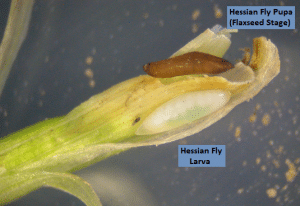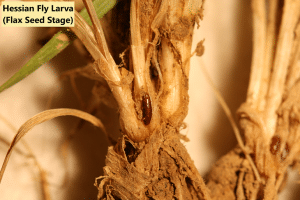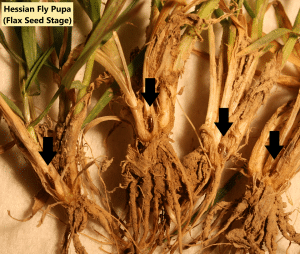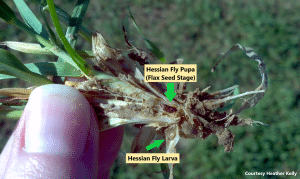 The Hessian fly has been responsible for tremendous wheat losses in the past. Hessian fly larvae feed on stems at the base of plants, hidden behind the leaf sheaths. Larvae are reddish at first emergence and turn white or greenish white as they mature. Larvae are legless, resemble small grains of rice, and are approximately 1/4 inch long when fully grown. The pupae, or flax seed stage, are brown in color but otherwise similar to the larvae. Tennessee typically does not have significant problems with this pest. However, early planted wheat is susceptible to infestation. Planting after Oct. 15 (i.e., the “fly free date”) will greatly reduce the likelihood of serious Hessian fly infestations. Also, avoid planting wheat as a cover crop prior to the fly free date. Volunteer wheat is a good fall host for this pest and any volunteer wheat should be destroyed before September. Plowing under wheat stubble after harvest may help reduce subsequent infestations in the fall. Although some varieties are available with resistance to Hessian flies, there are no varieties with adequate resistance to the fly biotype most common in Tennessee (Biotype L).
The Hessian fly has been responsible for tremendous wheat losses in the past. Hessian fly larvae feed on stems at the base of plants, hidden behind the leaf sheaths. Larvae are reddish at first emergence and turn white or greenish white as they mature. Larvae are legless, resemble small grains of rice, and are approximately 1/4 inch long when fully grown. The pupae, or flax seed stage, are brown in color but otherwise similar to the larvae. Tennessee typically does not have significant problems with this pest. However, early planted wheat is susceptible to infestation. Planting after Oct. 15 (i.e., the “fly free date”) will greatly reduce the likelihood of serious Hessian fly infestations. Also, avoid planting wheat as a cover crop prior to the fly free date. Volunteer wheat is a good fall host for this pest and any volunteer wheat should be destroyed before September. Plowing under wheat stubble after harvest may help reduce subsequent infestations in the fall. Although some varieties are available with resistance to Hessian flies, there are no varieties with adequate resistance to the fly biotype most common in Tennessee (Biotype L).




